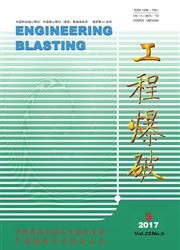

 中文摘要:
中文摘要:
传统小波变换等时频分析方法在提取水下爆炸信号时具有各自的局限性,为了获得金属导爆索水下爆炸信号的特征,采用HHT方法对信号特征进行提取。结果表明:EMD具有自适应性,能够将冲击波信号进行分解,适合金属导爆索水下爆炸冲击波信号的分析;采用HHT方法能够有效提取金属导爆索水下爆炸信号的时频特征,冲击波信号的优势频率主要集中在0~40kHz,特别是20kHz以下的低频能量最大,高于80kHz以上频段能量分量很小;冲击波压力信号能量主要集中在40kHz以下,尤以5kHz以下频带能量最高。能量主要集中在前80μs内的3个子区间内,各子区间能量峰值对应的时刻分别为3、5和16μs。
 英文摘要:
英文摘要:
Traditional wavelet transform time-frequency analysis method has some limitations when the signal of underwater explosion is extracted. In order to obtain the time frequency characteristics of under- water explosion signal of metal detonating cord, the time frequency signal data were extracted hy HHT. The result showed that the signal of shock wave could be decomposed by EMD with its self-adapta- bility, and it was suitable to analysis of underwater explosion signal of metal detonating cord. The HHT method could effectively extract time-frequency characteristics of the signal of metal detonating cord under- water, the main frequency of shock wave signal was distributed between 0 to 40kHz, the largest energy was concentrated in low frequency signal that lower than 20kHz, and the frequency higher than 80kHz accoun- ted low proportion. The energy mainly concentrated before 80μs within 3 sections, and the time corre- sponding to the peak energy of each section were 3μs, 5μs and 16μs respectively.
 同期刊论文项目
同期刊论文项目
 同项目期刊论文
同项目期刊论文
 期刊信息
期刊信息
